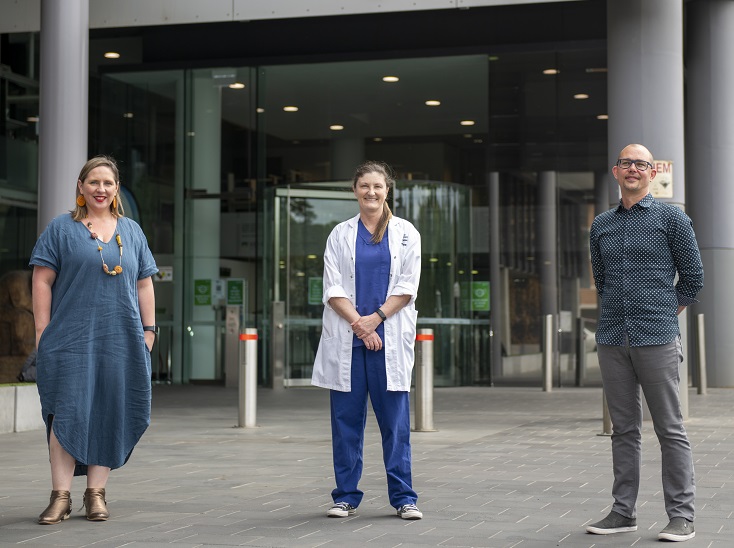Patients are collaborators along with structural biologists, immunologists and neurosurgeons in the groundbreaking brain cancer research being conducted by the tight, multidisciplinary team being led by WEHI’s Associate Professor Misty Jenkins.

The research, funded by an NHMRC Synergy Grant, will use genetically engineered blood cells designed to specifically kill cancer cells. The technology makes new cell therapies possible for brain cancer which has confronting survival rates and hasn’t seen advances in therapies in decades.
Associate Professor Jenkins says the combination of multidisciplinary skills is essential.
'The whole grant is about designing new therapies for brain cancer and to do that we’re looking at designing engineered T cells which are essentially made from the patient’s blood and which then go into the brain and kill the tumour,' she says.
'That sort of approach requires everything from basic protein chemistry, the building blocks of the receptor design itself, and tailoring, engineering these receptors in ways that are really quite extraordinary.
'So we are really breaking the components down to the individual receptor and engineering them. That’s where I’ve worked with protein chemists and structural biologists on the basic, fundamental building blocks, but then all the way through – so the fact that we can design these amazing new age receptors, we then need to know what the target is in the brain. That’s where our clinical collaborators are absolutely essential.'
Clinical knowledge was a gap, Associate Professor Jenkins says, so she started attending clinical meetings to learn more about the patient experience, to learn more about clinical trials and a surgeon’s and oncologist’s point of view.
That is how she met Professor Kate Drummond, Director of Neurosurgery at the Royal Melbourne Hospital.
'Kate is a leading, pioneer woman neurosurgeon. She works very closely with us to provide fresh brain tumour tissue, straight out of surgery, so we can say, "what’s different about that brain tumour compared to healthy cells" and then we know what to target,' says Associate Professor Jenkins.
'We can take these receptors and direct them to tumour specific targets. It’s bringing the receptor design and protein chemistry and linking it with the clinic. I sit right in the middle, to bridge that gap.'
Professor Drummond says there is an “enormous atmosphere of cross fertilisation” at Parkville in Melbourne and the lynchpin is patients and data.
'We provide tissue for so many different projects. For every brain tumour I remove there would be 2-3 people behind me waiting for bits of tissue for their research,' says Professor Drummond.
'Every patient who comes for neurosurgery is asked to sign a consent form to donate their tissue. It is very rare for people to decline, they want to contribute to research.'
Professor Drummond explains that the problem with brain cancers is that they are one of the most complex and that the brain is 'very good at keeping things out'.
'We know this technology works. The challenge is finding the target for the CAR T cells and making it available for the majority of patients. The technology is there, it’s how do we apply it.'
Professor Drummond has a number of grants, including a $2.6 million grant through the Medical Research Future Fund Australian Brain Cancer Mission announced in March where she is working with others to develop and demonstrate the impact of an online survivorship platform, co-produced with brain cancer survivors and carers, to streamline access to treating teams, peer support and evidence-informed supportive care, in a private and secure environment.
She says the grant will ultimately enable better care for brain cancer patients.
In terms of treatment, Associate Professor Jenkins says the Synergy Grant is “the perfect marriage”.
'My approach is, I think this general area is interesting but what do the clinicians want, what do they need? I started talking to the structural biologists and structural immunologists about receptor design and was the glue that kind of pulled us together and said, "you know what, we actually have a really great thing here and it’s a really interesting question".
'I’ve been working on building this program and vision for research for the last five years. So, this Synergy Grant is really the culmination of that. We’ve got some nice preliminary data we’ve published, some papers showing that our pipeline works and now we want to take that to the next level.'
Professor Drummond says Australia has a small population with 1400 brain tumours a year.
'But we get a seat at the table for the international trials, we do very well in first time human trials,' she says.
'Australia does really stand out in CAR T cell research.'
Other collaborators on the research are Associate Professor Matthew Call, also at WEHI where he is joint division head of Structural Biology, and Associate Professor Sarel Fleishman who heads the Fleishman Lab for Protein Design at the Weizmann Institute of Science in Israel.
Find out more about other Synergy Grants.
Further reading:
- Novel high-affinity EGFRvIII-specific chimeric antigen receptor T cells effectively eliminate human glioblastoma in Clinical and Translational Immunology, 9 May 2021.
- De novo designed receptor transmembrane domains enhance CAR-T cell cytotoxicity and attenuate cytokine release preprint.